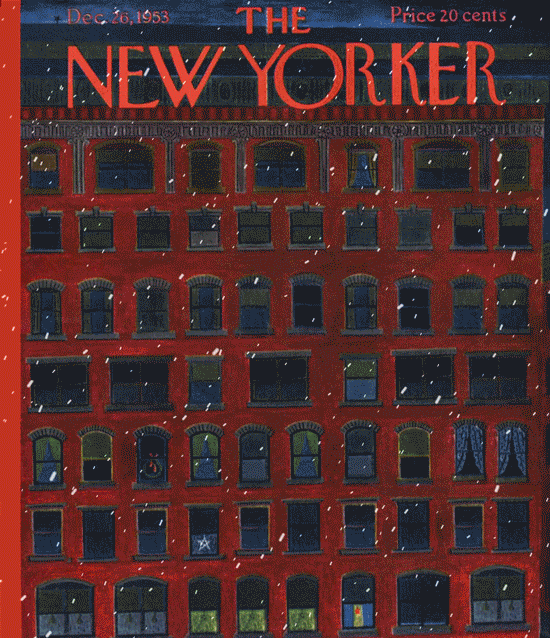
A triangle is a triangle is a triangle, right? Not so during the holiday season when any vaguely triangular shape telegraphs precisely one thing: a Christmas tree and, by extension, the festive holiday season that surrounds it. Just consider the above New Yorker cover from 1953 — even if you didn’t have the small Yuletide scenes in the windows, the light-up triangle layout plus the December date plus the falling snow wouldn’t register as anything else but Christmas.
The reaction is automatic. But have you ever wondered about how these symbols have slipped into our cultural consciousness, and why? We did — and it led us to Christmas: A Biography by Judith Flanders. The author and historian leaves no observance unturned, investigating with equal enthusiasm everything from the December 25th date to the reason why slasher films are so popular come Christmastime. Here, some fun facts from the book — including, of course, the origins of that tinseled tree.
Bright Young Thing
The holiday reindeer herd we’re all familiar with — Dasher, Dancer, Prancer, et al. — come into play in 1823, first named in Clement Clarke Moore’s A Visit from St. Nicholas. Rudolph, however? He’s over a century younger than his furry brethren — and with a decidedly commercial provenance. The rosy-nosed reindeer was invented in 1939 by a copywriter for the now defunct department store, Montgomery Ward; he appeared in a children’s pamphlet.
Spruces Almighty
Flanders traces the, ahem, roots of the traditional Christmas tree back to the Middle Ages in England, when churches, streets and private homes were regularly decorated with holly and ivy during the winter, including, according to one historian, the summer maypoles. In Germany, more origin stories abound — one involves Thor, another apple blossoms — but of particular importance is the fact that the feast day of Adam and Eve happens to coincide with… the night before Christmas. “Paradise plays opened with a scene set in the Garden of Eden,” writes Flanders, “the tree of knowledge represented in midwinter by an evergreen fir with apples tied to its branches.” Those paradise trees were set into wooden pyramids, surrounded by ornaments and candles; in time, the base pyramid disappeared and those extras were tied directly onto the trees. The first recorded decorated indoor tree was in Strasbourg in 1605 — it was “adorned with paper roses, apples, wafers, gilded sweets and sugar ornaments,” Flanders continues. “It was what, a few years later, would be given a new name — a Weihnachtsbaum, or Christmas tree.”
Mad for Marzipan
In the 1800s, believe it or not, marzipan was a popular tree ornament in Germany. That sticky-sweet sugary confection was sculpted into tiny animals, such as squirrels with nuts in their paws or a rabbit nibbling on cabbage leaves.
A Man By Any Other Name…
St. Nicholas, Samichlaus, Krampus, Klapperbock, Klaubauf… If you think you know the mythology behind Santa Claus, think again. Flanders dives into all the legends behind the jolly fellow and unearths some surprising details. For instance, did you know that Coca-Cola is largely responsible for the current Santa stereotype? Its holiday campaigns, from the Thirties to the Sixties, and again in the Eighties and Ninetes, “spread, like the drink itself, across the globe, promoting what had become the standard image: a white-bearded man wearing a red jacket trimmed with white fur, belted across a substantial belly, red trousers and black boots and, frequently, a red pointed cap with white fur trim.” Which isn’t to say he was the first or the original, “but because the advertisements ran for so many years, in so many places,” they helped popularize that particular image of Santa.
Got Coal?
We all know that naughty kids get coal from Santa, but it could be worse. In Zurich, during the 1900s, “bad children received horse manure and rotten vines (although not yet in stockings),” writes Flanders.
#ToryDaily
